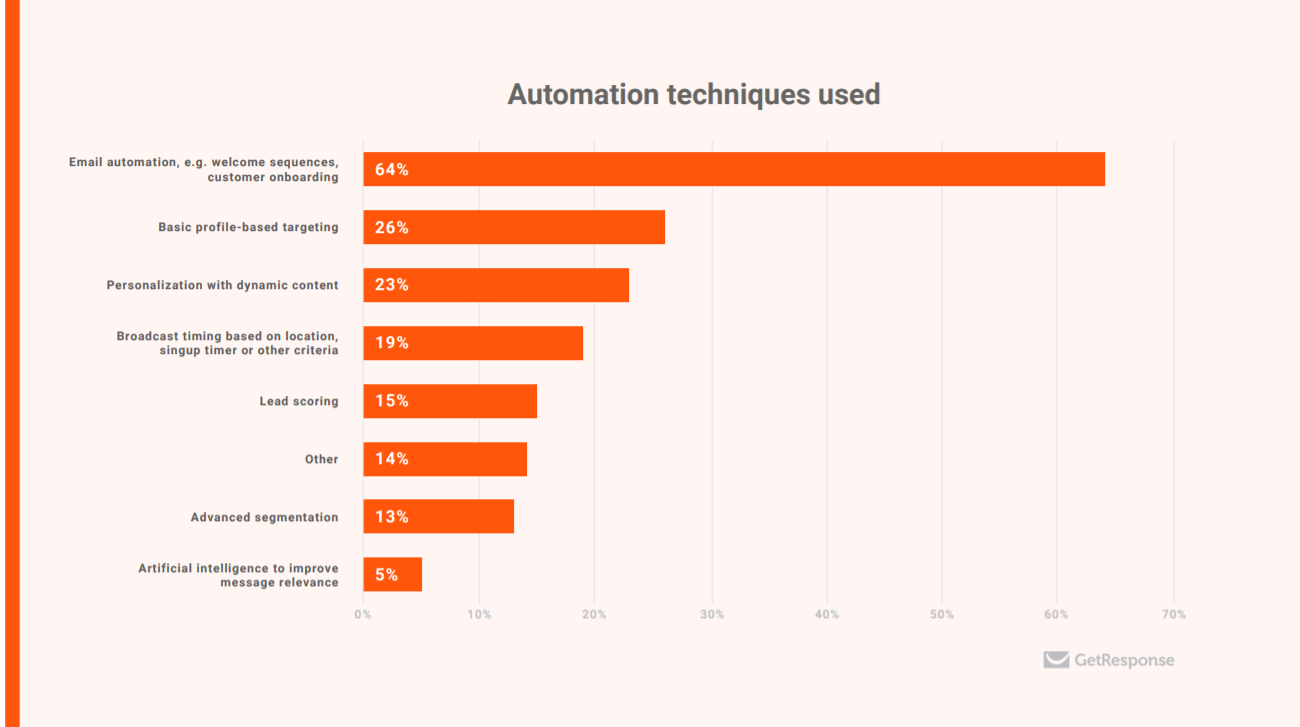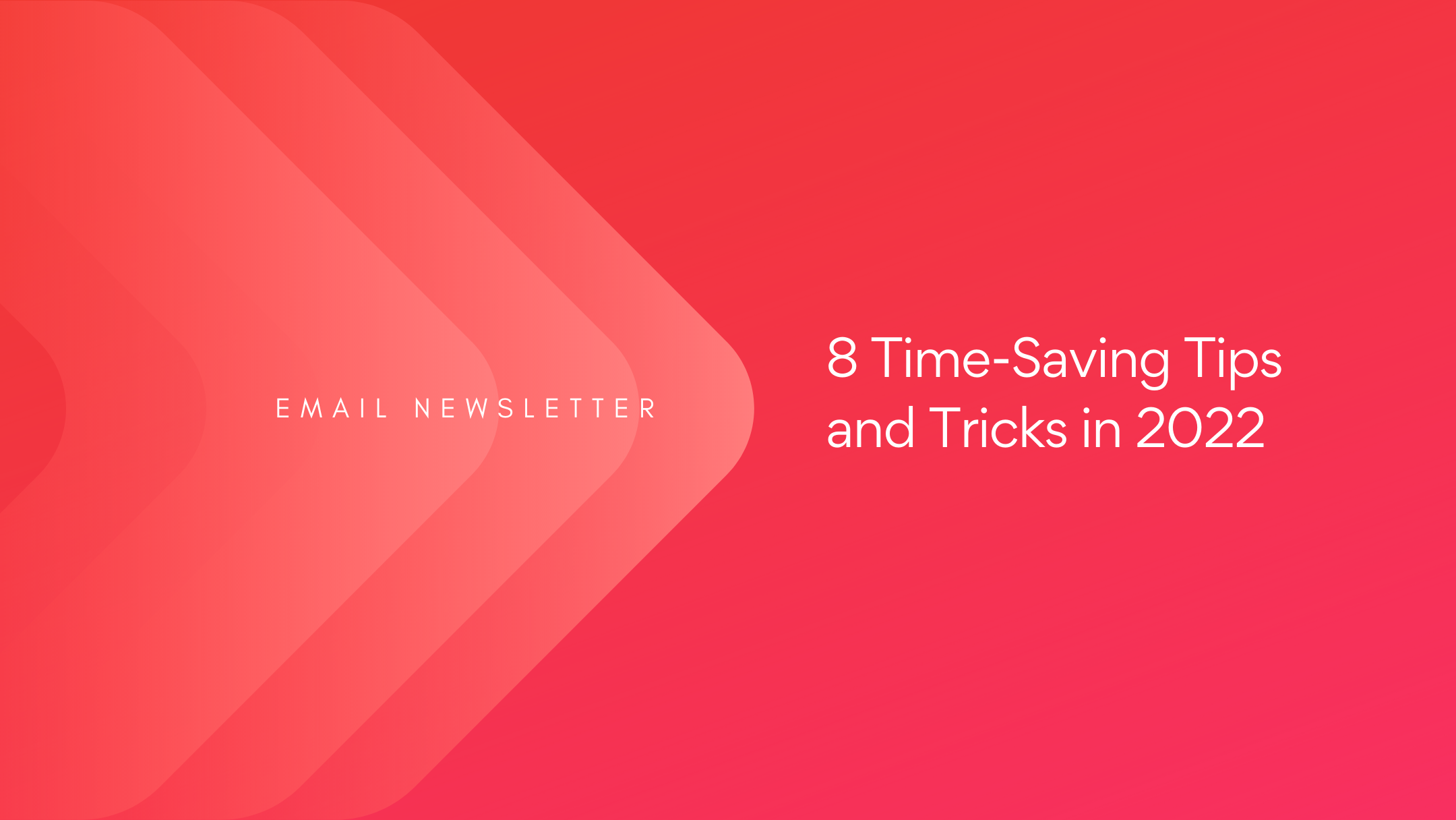Have newsletters not really been a priority for your business? Let’s be honest; most marketers tend to put their email campaigns on the backburner and let automated (or outdated) processes run the show. This is understandable since more than 40% of marketers saw budget cuts to email since the pandemic. But, engagement and site traffic can start declining — which is why we have put together 8 time-saving email newsletter tips and tricks.
Need a little more convincing as to why you should keep reading? According to the DMA, email marketing brings in $38 of revenue for every $1 spent on it, which means that it has an ROI of 3,800%! And emails are 40X more likely to bring in new customers than social media. If you’ve been thinking, “should we be spending our time on newsletters when we can’t associate any sales to it,” it most likely is from spending hours focusing on the wrong areas.

As Stephen R. Covey notes: “The key is in not spending time, but in investing it.” (Source) And if there is a field where this saying is most relevant, that is email marketing! Marketers are always looking for time-saving email marketing tips to help bring an email campaign to life.
Time is everything when you plan your email marketing strategy; how you invest it -instead of spending it- will get your brand to lead the market. Below, we share 8 time-saving email newsletter tips and tricks to make time management return results for your business.
8 Time-Saving Email Newsletter Tips and Tricks in 2022
1. Plan ahead
Most businesses incorporate a content calendar for their social media strategy but don’t utilize an email marketing calendar. However, having such a calendar has proven to be extremely time-saving when scheduling your newsletters. Start with a detailed calendar that will include everything about future campaigns.
Newsletter Tips and Email Calendar Must-Haves:
- Subject line: The email subject line is the first text the recipient will see when your newsletter hits their inbox. This one line will determine whether your email is opened or sent right to trash, so you will want to ensure it’s optimized to your audience.
- Design (including mobile optimization): One thing to consider for a mobile-optimized newsletter is that mobile devices only show 25-30 characters, compared to 60 characters on a typical desktop email, according to a post by Return Path.
- Content: The trick for email marketers to look uncluttered revolves around two things: concise copy and enough white space in the design.
- Preview text: Preview text is the bit of text below or next to an email’s subject line in the inbox and gives the recipient some insights into what’s inside the email.
- Delivery date: According to Moosend’s analysis, they discovered that Thursday was the best of the weekdays in terms of the highest open rate, and Tuesday was the second-best day.
- Recurrence: This is a newsletter that is sent to a certain segment of customers on a repeating schedule.
Keeping your newsletters on a consistent schedule that has been planned can allow for huge time-saving. Make sure that your team track reports regarding the performance so that you can measure the results over time and monitor progress. And don’t forget about recurrence: your campaigns should be dispatched regularly enough for your recipients not to forget about you and for you to avoid unsubscribes.
2. Stick to your plan
A well-crafted email newsletter calendar is great, but it won’t do anything if you don’t stay accountable to it. The thought of sticking to a calendar is a nice sentiment—but if something more pressing comes along, you may not stick to your plan. Staying accountable to your calendar will keep your promise—to yourself and your audience. And bonus, ideas tend to come easier since you have a clear preview of what’s to come.

Sticking to your plan also helps you monitor your campaign recurrence. Sending your newsletters on a regular basis will save you time but also money in the long run. If your subscribers don’t receive all the necessary information and at the exact time you want them to, this will most likely affect your conversion rates.
Your team should be strict with deadlines and take advantage of all the back-end work done to overcome the restrictions time sets. Try to remain consistent with the same day of the week you are sending out your newsletters, whether they are delivered weekly or monthly. Establishing a routine can help align your team to stay focused, and it will soon become second nature to your team to get the newsletter out for the deadline.
3. All you need are templates
Have you created a design you absolutely love? Then, you shouldn’t waste time setting every newsletter from scratch. Consider saving time by turning your design into a wonderful template to use again and again.
That is why almost all marketers benefit from an email template builder software to make their lives easier. You can create newsletters in an easy-to-use and simple to assemble format through its usage. It is worth the extra effort to design a template you can repeatedly use, thus providing a consistent experience for your subscribers.
When choosing to craft template newsletters, remember that you want them to represent your company effectively. The primary focus should always be a stunning, readable design because your emails are meant to be read and ultimately generate leads for your brand.
4. Subject lines that get to the point
The subject line is a crucial element in the email campaign creation process, given that it needs to grab your subscribers’ attention immediately. When it comes to subject lines, shorter has proved to work better – especially during an era in which your newsletter will probably be read on a mobile phone.
Short subject lines tend to win out. As discussed above, research shows that around 41 characters are the optimal length for a subject line. Still, some marketing experts suggest going even shorter. Backlinko founder Brian Dean says subject lines that do not exceed 16 characters have significantly higher open rates.

Keep in mind that it is not just brevity that matters but also balance. Anything longer or shorter than that, and your open rate drops. So, you must avoid making your subject line too small because that will get your idea lost on your subscribers.
The same balance should be used in the wording chosen as well. We all get the need to create funny or attention-grabbing subject lines. However, in an effort to do so, many marketers embarrass themselves or end up pushing away some of their subscribers. Remember that short and provocative doesn’t translate into sketchy or offensive.
5. Metrics are your fortune cookie
Can you tell which sending day and time is most likely to offer you higher open rates? What type of subject lines performs better for your audience? What CTAs present a better conversion rate?
Time investment in your newsletter statistics means better performance and fewer questions down the road. Track your metrics, explore the tendencies, make predictions, and adjust your newsletter according to your findings. Remember that no matter which email marketing software you have chosen to utilize, it most probably provides you with some form of analytics to take advantage of.
You can enhance the features offered by using them in conjunction with Google Analytics. The data obtained from Google Analytics will help you set more accurate campaign goals, which, in turn, boost your conversion rates.
6. Automate as much as you can
Email marketing requires hard work, seeing that you have many aspects to bear in mind: campaign creation, design, content, scheduling, reporting.
The good news is that newsletters are largely automatable. You can set up your automated emails once and then have them do the job for you. Once you have created your automated email series, you can monitor it while it is being delivered automatically to people who subscribe to one of your email lists.

Automated emails allow you to build and strengthen your relationship with existing and new customers at a time when their interest in your brand has reached its peak. Do you need to save even more time through their usage? Create a plan to specify when you need them delivered over the year.
Also, when you stop creating your newsletters manually and employ an artificial intelligence tool, it results in you saving valuable time. You avoid repetitive tasks while also improving campaign performance analytics and subscriber engagement.
Take advantage of AI tools to perform processes such as:
- Writing high-performing email subject lines.
- Creating personalized newsletters from scratch.
- Improving conversion rates based on the data extracted from your campaign performance.
- Automating sending time-based on when your recipients are most likely to open emails.
7. Repurpose your best content
You probably invest lots of time and energy in creating amazing content. Why not include a mix of timely content in your content strategy? This way, you improve SEO and answer your website visitors’ common questions.
There is always some piece of content you could easily reuse. If you lack inspiration, chances are that there is an idea in your archives that you could re-format and create something almost brand new. It is worth repurposing content across your campaign and into various formats.
For instance, if you have a blog post regarding a product launch, you could pull that copy and include it in the campaign’s newsletter or social media posts. This will not only buy you time but also crafts a consistent message to be used in different marketing channels.
8. Know something about coding
Having a basic knowledge of HTML saves you time and helps you get a better preview of your email campaigns. No reason to trouble yourself with learning how to code an email from scratch, but if you know some basic rules of HTML, you can make quick adjustments in email newsletter templates. Why pay for a developer when you could craft things on your own?
One of the main aspects of a successful HTML email is knowing where it is read. If your recipients are going to read it in certain email clients such as Outlook, this might point you toward using plaintext. Maybe you will have to test some email clients and take guesses about the kind of audience with which you are dealing. Keep a record of what email clients you want to check most each time you dispatch a newsletter. And don’t neglect to optimize it for mobile since a great percentage of your recipients will be viewing your campaign via a mobile device.
Also, try to keep a snippet library to help you stay organized and make simple changes to your newsletters. This could be as simple as a Google doc of code snippets that you can later use for different parts of your templates.
Final Thoughts
By its own definition, email marketing is straightforward and personalized and can offer you results in terms of new customers. For this, you must be aware of the content you are going to include in every future newsletter.
Never wait until the last minute to set your newsletters up because right before you dispatch them to thousands of subscribers, pressure will be out of control. Therefore, it is highly recommended that you have a pre-send checklist where you can check all the actions required for your email campaign to finally land in your recipients’ inboxes.
You can spend time on useful and useless things, but if you call it “investing,” you will definitely invest it in something valuable for your brand’s reputation. So, choose your goals wisely and make the time you spend on your newsletters an investment, not an expense.
Author Bio:
Maria Fintanidou – Product Marketing Copywriter, Moosend

Maria Fintanidou works as a Product Marketing Copywriter for email marketing automation software Moosend, having created the Help Articles (FAQs) and overseen the platform’s translations in Greek and Spanish. She loves exploring new cultures and ways of thinking through traveling, reading, and language learning.
